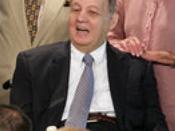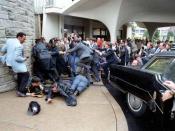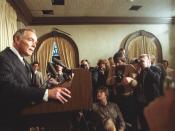PRELUDE
Shortly after 2:30pm on Monday March 30, 1981, six shots rang out as President Ronald Reagan walked to his limousine in front of the Washington Hilton Hotel. Moments later James Brady, the President's Press Secretary, lay on the wet pavement of a Washington D.C. sidewalk in a pool of his own blood, hit in the head by an assassins bullet. President Reagan, the intended target of the crazed gunman, was shot in the chest just under his left armpit. Whisked away in a frenzied rescue by the Secret Service, the President was able to walk into George Washington University Hospital under his own power. Two hours and 2ý quarts of blood later, Reagan was on the road to a full recovery that would witness a stunning reelection victory and some of the highest approval ratings in American history.
James Brady, was not so lucky. Suffering from extensive brain damage he would never fully recover.
He did, however, return to the American political scene. Accompanied by his wife Sarah and galvanized by an organization known as Handgun Control Inc., the name "Brady" has come to symbolize the greatest political battle waged in recent memory over one of the greatest nemesis's of American society, the handgun.
INTRODUCTION
Anti-gun proponents claim the Reagan assassination attempt symbolizes all that is wrong with American gun regulations. They are quick to point out gun control laws did little to prevent a deranged individual from purchasing a handgun in Dallas, Texas, moving the weapon 1,600 miles across state lines, then using it in an assassination attempt on the most powerful man in the world. To them, this unforgivable act of ruthless terror easily underscores the absurdity of what Americans have accepted as gun control.
John Hinckley, the man who shot President Reagan, never fully realized...


